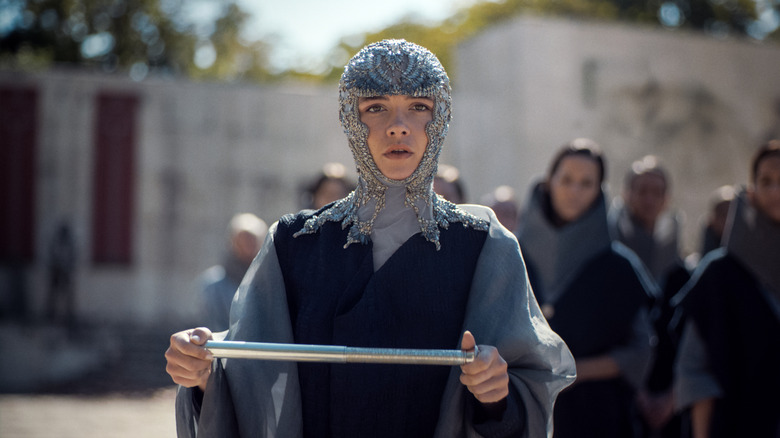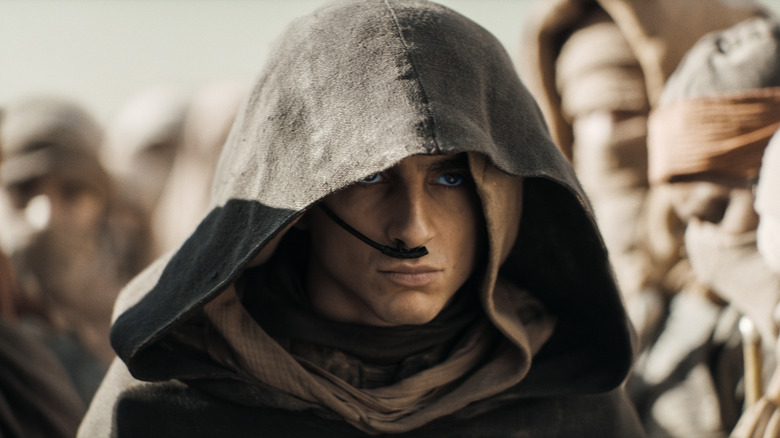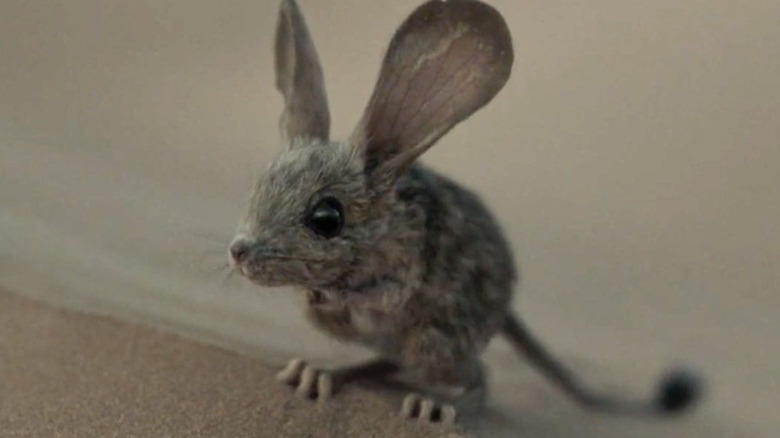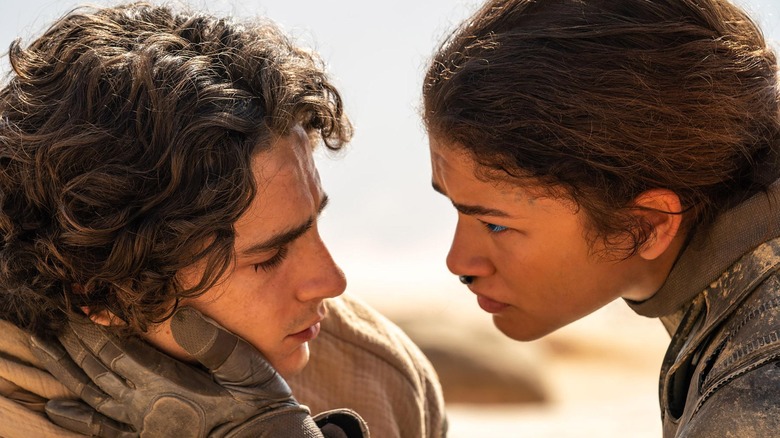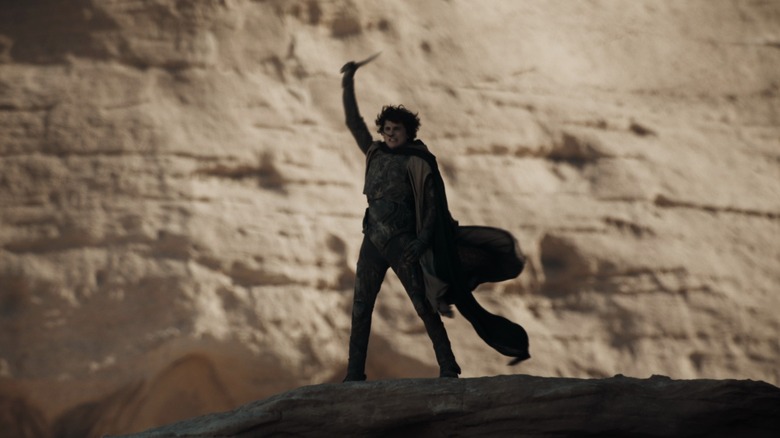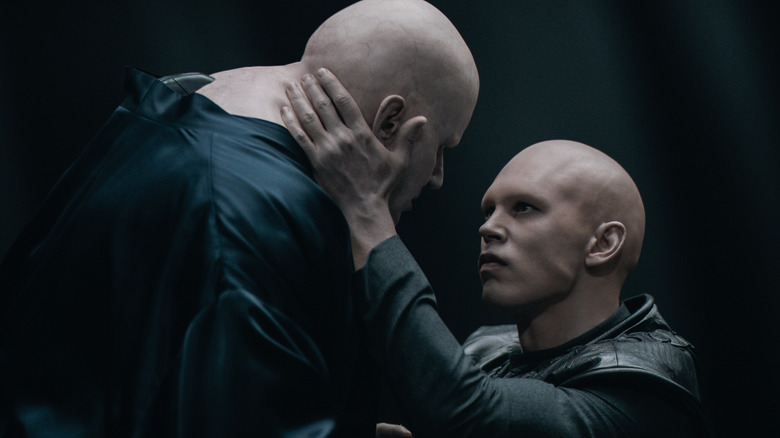A Handy Guide To Dune: Part Two's Weirdest Terminology
Warning: This article contains spicy spoilers for "Dune: Part Two."
Words are everything in the story of "Dune." Empires rise and fall based on a single message sent from the desert world of Arrakis, as we see late in "Part Two" when Paul Atreides (Timothée Chalamet) reaches through the stars to challenge the very might of the Padishah Emperor (Christopher Walken). In author Frank Herbert's massively influential 1965 novel, meanwhile, almost every chapter is preceded by short excerpts written by Princess Irulan (whom we finally meet in the sequel, played by Florence Pugh) laying out assorted sayings, family history, and other character-specific insights detailing the legend of Paul Atreides. At the very end of the book, Herbert even includes an exhaustive glossary, laying out a "Terminology of the Imperium" for readers who might have found themselves adrift at sea amid the complicated world-building, terminology, and other incredibly nerdy mythology compiled by the sci-fi writer.
In director Denis Villeneuve's surprisingly faithful adaptation (which /Film's Chris Evangelista reviewed here), however, audiences flocking to theaters don't quite get to enjoy the same benefits that readers did. With no time to stop and explain complicated concepts, as Herbert does quite often in the original, the film characters breeze through dialogue containing titles, rituals, and other phrases at a rapid-fire clip that might leave you feeling like a bad spice-trip. But don't bury your head in the sand just yet! For all those who don't know their Sardaukar from their Shai-Halud or their Fremen from their Fedaykin — in other words, the vast majority of normal people who don't spend way too much time immersing themselves in such dense lore and myth-making — this explainer is for you.
Kwisatz Haderach
Is that the portentous inevitability of a horrifying destiny hanging over your head, or are you just happy to see me? Admittedly, the entire concept of the Kwisatz Haderach was first established and explained in the 2021 "Dune," primarily through that early scene between Paul and the Reverend Mother Gaius Helen Mohiam (Charlotte Rampling) involving the Gom Jabbar — a poison-tipped needle that the Bene Gesserit witch would've plunged into the neck of young Paul had he failed to pass the pain test. This was necessitated because of the actions taken by Paul's mother, the Lady Jessica (Rebecca Ferguson), who flouted the decrees of her Bene Gesserit order and delivered Paul as a baby boy (yes, the space-witches have the ability to decide the sex of their children) rather than the girl that she was ordered to produce. So why'd she break the rules? Well, she thought that she could fast-track the creation of the mythical Kwisatz Haderach.
Neither "Dune" film explains what this truly means beyond the obvious messianic implications, but filling in the blanks is our specialty. The Bene Gesserit, a mysterious and quasi-religious organization exercising a wide-ranging influence on the Empire's politics, have orchestrated genetic mixing and matching between the Great Houses for millennia in order to engineer a long-prophesized figure: essentially, the one male capable of Bene Gesserit powers who would stand as their chosen one and the ultimate evolution of the human race. Gifted with the unique ability to see both the past and future (something something unlocking genetic memories, just go with it), the true Kwisatz Haderach could be a formidable figure indeed. Fingers crossed, we'll get to see the fallout of this chain of events in a future adaptation of "Dune: Messiah."
Muad'Dib
When the Harkonnens are being mean to House Atreides, this is who they're being mean to. In all seriousness, both "Dune" and "Dune: Part Two" have taken pains to preserve many of the various religious terms, political titles, and even nicknames that the young man of destiny Paul Atreides has acquired with every feat he pulls off. The first movie introduced the prophecy surrounding the Lisan al Gaib, a term used among the Fremen (that is, the Indigenous population that calls the planet of Arrakis home) for the figure meant to lead them to salvation. Literally translated as "The Voice from the Outer World," the legend speaks of an off-worlder who comes to their home world and fulfills a series of improbably and highly specific prophecies — ones that were artificially planted among the people by the Bene Gesserit in past centuries, as it turns out, in order to help pave the way in case another Bene Gesserit and her offspring (in this case, Lady Jessica and Paul) ever found their way to Arrakis.
So, about Muad'Dib. In both the book and movies, Paul takes a special interest in the tough little desert mouse known as Muad'Dib, a symbol among the Fremen for survival in the toughest of environments. In "Part Two," we see the moment Paul chooses this as one of his Fremen names — the public-facing moniker identifiable to all Fremen that signifies his advancement into manhood. But if there's a public name, then shouldn't there be a private one, too? I'm glad you asked, rhetorical questioner!
Usul
Between Lisan al Gaib, Muad'Dib, and now Usul, Paul Atreides might as well come for the crown of never-ending titles currently held by Daenerys Targaryen, The First of Her Name, the Unburnt, Queen of Meereen, Queen of the Andals and the Rhoynar and the First Men, Khalisee of the Great Grass Sea, Breaker of Chains and Mother of Dragons, and the late Mad Queen who basically turned into fantasy-Hitler by the end of "Game of Thrones." Yeah, those who know their "Dune" lore might pick up on a parallel or two between these figures, eh?
The first "Dune" begins with Paul wandering through one of his prescient dreams of the future, specifically one in which the Fremen Chani (Zendaya) is telling him about the beauty of Arrakis. Later on, Paul admits to the Reverend Mother that there's one dream in particular that he keeps returning to — one where Chani asks about the abundance of water on Paul's home world of Caladan and, in the process, refers to him intimately as "Usul." Although this is used much more liberally in the book, it's worth pointing out how this factors into Paul's journey, as well. Every member of a Fremen clan or village (referred to as a "sietch") receives two distinct names. While anyone from any sietch on Arrakis would know Paul as Muad'Dib, only those Fremen under Stilgar's (Javier Bardem) sietch, known as Sietch Tabr, would know him by the private name of Usul. As laid out in the movie, the meaning of this word translates to "the strength of the base of the pillar" and, ultimately, this became Chani's pet-name for her lover.
But, based on how "Part Two" ended, clearly there will be trouble in paradise moving forward.
Fedaykin
"Long live the fighters!" Every glimpse Paul receives of the future comes with ominous signs on the horizon. If he avenges the murder of his father Duke Leto (played by Oscar Isaac in the first film), his actions inevitably go on to inspire a holy war waged in his name that results in the deaths of millions. So when even the most sinister call of destiny proves too much for Paul to refuse, the ground is laid for the rise of his most fanatical supporters. These, in short, are the Fedaykin mentioned several times in "Dune: Part Two." The Fremen are incredibly skilled killers as a natural by-product of living in some of the harshest conditions of any planet in the Imperium. So it makes quite a lot of sense that, as Paul rises in stature and importance among them, he would surround himself with the absolute best of the best. We've seen their battle cry in action, though the dialogue was given to Paul in an attempt to stir them up for the third-act battle to come. In the book, Fedaykin are described as "death commandos" who are willing and able to sacrifice their lives at the drop of a hat if it means the survival of whoever they're pledged to protect. It's small wonder that "Part Two" ends on such a downer of a final note, despite Paul getting everything he ever could've wanted (on the surface, at least). With such a loyal army at his back, there's no telling what he might be capable of in the future.
Na-Baron
"Dune: Part Two" might throw one of the biggest curveballs at audiences, revealing that Lady Jessica is actually Baron Vladimir Harkonnen's (Stellan Skarsgård) illegitimate child, but the future of House Harkonnen remains clear: the Baron's nephew, Feyd-Rautha (Austin Butler). Groomed to be the more charismatic and deadly successor to the Baron, particularly compared to the likes of his ineffectual brother Beast Rabban (Dave Bautista), Feyd-Rautha represents far more than a killer swordsman. The Bene Gesserit have kept a close eye on the young prodigy, holding him as an ace up their sleeves in case Paul should prove not to be the fabled Kwisatz Haderach, after all. That provides an opening for the figure known among the Harkonnens as the Na-Baron — an unusual-sounding term that signifies him as the heir apparent to the Baron's title.
All of those plans go up in smoke after the occupying Harkonnen forces seriously overplay their hand and, in their attempts to wipe out the Fremen rebels, inadvertently pave the way for Paul's bold power grab with the Emperor himself. One might be tempted to think that the Harkonnens are pretty bad at this whole "politics" thing, even after overthrowing House Atreides in the previous movie in what felt like the span of 24 hours, but going all-in on a sociopath like Feyd-Rautha makes quite a lot of sense when you realize how esteemed he was in the eyes of the all-powerful Bene Gesserit. With Beast having failed to keep a firm grip on Arrakis, the Na-Baron was meant to arrive as a savior-figure who could unite the desert world under his rule and keep the Harkonnen line flourishing. Now, with secret Harkonnen Paul in charge, the bloodline will ironically continue — just not the way anyone expected it to.
